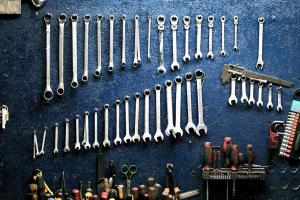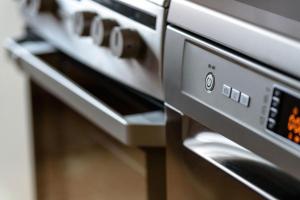In this post, Cleveland Containers, offer some top tips and advice on cleaning stainless steel equipment in the electrical sector.
We work with steel on a daily basis, as we clean and reuse old steel shipping containers into many different weird and wonderful creations, from pop-up shops to garden sheds and everything in between. Essentially, we know a thing or two about keeping it looking its best. Hailed as the saviour of all materials, it’s highly regarded due to its resistance to corrosion, staining and reaction – something which sets this alloy apart from its counterparts.
Stainless steel has always been apparent in the electrical industry, with everything from appliances to plug sockets… even some electrical equipment is made out of it. It really does have a wide variety of uses:
 Electrical appliances, e.g. fridges, washing machines, dishwashers
Electrical appliances, e.g. fridges, washing machines, dishwashers- Electrical plug sockets
- Electrical tools
- Electrical enclosures
All stainless steel will need to be cleaned and looked after, from keeping power tools to electrical appliances and everything in between clean.
Contrary to popular belief, this metal is not invincible and with the wrong upkeep, it can become tarnished or pitted. This guide will aim to fully inform you of most common wonders and wrongdoings of stainless steel, and help you to keep your equipment as clean as possible.
Why is the metal the best choice for your business?
Stainless steel has become popular for several reasons, one of the main reasons being its ability to maintain its cleanliness. Whereas other metals can be difficult to clean as they shed particles and keep a firm hold onto external substances; stainless steel is non-porous, making it effortless to clean whilst keeping its aesthetically pleasing appearance.
When cleaning electrical equipment, it’s important to bear in mind that safety is of paramount importance.
One of the biggest misconceptions about the metal is that it doesn’t rust. Whilst it’s one of the least corrosive materials on the market, it’s important to remember that without the proper care and cleaning, it’s still susceptible to pitting and staining.
Stainless steel possesses a thin protective layer which can be damaged, so you have to be careful not to spoil this. Abrasion from chemicals can damage this protective layer over time. The easiest way to avoid this is to sterilise and clean your equipment on a regular basis as ultimately, by increasing the longevity of your stainless steel product, you will save yourself time and money.
How to avoid damaging your equipment and ensure optimum use
The basics…
 Before you even start to clean your stainless steel equipment, you should make sure that you have the right tools. Avoid using abrasive cleaning products like scrubbing or wire pads, as they can scratch the equipment and ruin its protective layer. Instead, use something with a gentler touch when polishing and cleaning, like a microfiber cloth. Also, be careful when choosing chemicals – you don’t want to use anything that contains chloride as it can damage the surface of your equipment and cause it to rust.
Before you even start to clean your stainless steel equipment, you should make sure that you have the right tools. Avoid using abrasive cleaning products like scrubbing or wire pads, as they can scratch the equipment and ruin its protective layer. Instead, use something with a gentler touch when polishing and cleaning, like a microfiber cloth. Also, be careful when choosing chemicals – you don’t want to use anything that contains chloride as it can damage the surface of your equipment and cause it to rust.
Luckily, steel responds well to cleaning: you just need to follow certain rules. It’s fine to start with basic cleaning, before working your way up if needed.
For routine cleaning, warm water and a cloth will work fine on steel, and it’s the least risky option. Make sure you dry with a towel or cloth to prevent water spots. It’s really important you do this because if left, minerals in water can leave marks on stainless steel. When it comes to polishing, the best technique is to go along the grain of the metal.
Those extra tough marks…
If you’ve followed this advice so far but your equipment is still in need of sprucing up, then here are some more tips you can follow to help with the upkeep of your stainless steel.
Fingerprints
- Glass cleaner and a microfiber cloth works well for sticky prints.
- Alternatively, a mild liquid detergent in water will easily remove any fingerprints.
Heat and burn stains
- Whilst stainless steel can withstand temperatures of up to 2,600 ºC, it too can fall victim to tricky heat and burn stains
- To get rid of these, you can use all-purpose cleaner cream, which should be available at all reputable DIY stores. Then just rinse with water and dry.
Limescale
- If you have deposits of limescale left from water residue, then you’ll need to use an all-purpose cleaner cream and microfiber cloth, before rinsing with water and drying.
- Remove heavier deposits by soaking in a solution of three parts hot water and one-part vinegar (white vinegar or apple cider vinegar works best), followed by water and baking soda, then rinse and dry.
Scratches
- Stainless steel may be a hard material, but it can still suffer from scratches. In most cases they’ll be superficial and can be removed with either a proprietary stainless-steel cleaner or a car paint restorer such as ‘T-Cut’.

Add new comment